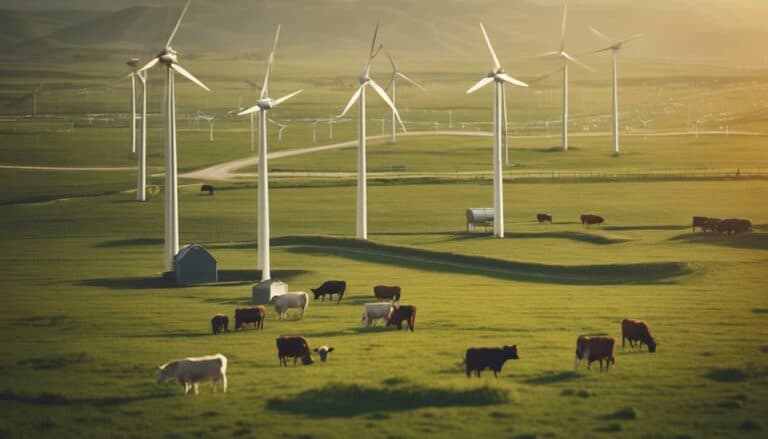Begin a journey to transform ranching supply chains, facing challenges like deforestation and complex relationships. Collaborate with stakeholders to create sustainable practices critical for the environment. Environmental risks loom due to lack of tracking and major retailers' influence. Leadership is key in forming robust partnerships and reducing costs sustainably. Drive positive change by working together, addressing risks, and supporting sustainability measures. The ranching industry's future hinges on sustainable development and strategic collaboration. Discover how these efforts shape the world of supply chains in ranching to forge a sustainable path forward.
Key Takeaways
- Collaborate with stakeholders for sustainable ranching practices.
- Implement effective tracking systems to prevent deforestation.
- Influence major retailers to support sustainable supply chains.
- Establish government agreements with slaughterhouses for sustainability.
- Practice robust leadership to drive positive change in the ranching industry.
Challenges in Ranching Supply Chain Sustainability
Despite commitments to deforestation-free supply chains, cattle ranching in Brazil continues to contribute substantially to deforestation, presenting challenges to sustainability in the ranching supply chain. Supply chain relationships in the cattle industry are intricate, with various stakeholders influencing environmental impacts and sustainable development. The environmental impacts of deforestation extend beyond land degradation to biodiversity loss and carbon emissions, urging a reevaluation of current practices for long-term sustainability.
In Brazil, ensuring food safety within the cattle ranching supply chain is important, as unchecked deforestation can lead to contamination of water sources and pastures. Sustainable development in this sector requires innovative approaches that balance economic interests with environmental conservation. Stricter regulations and monitoring mechanisms are imperative to steer the industry towards sustainable practices.
Collaboration among stakeholders is essential to address the complexities of cattle ranching in Brazil. By fostering transparent supply chain relationships and implementing sustainable initiatives, the industry can mitigate its environmental footprint while ensuring food safety and long-term viability.
Collaboration for Sustainable Ranching Practices
To enhance sustainability in ranching practices, fostering collaboration among stakeholders is paramount for driving positive environmental impacts and long-term viability in the beef industry. By working together, stakeholders in the ranching industry can implement sustainable practices that benefit the environment and the industry as a whole. Here are some key points to keep in mind:
- Collaboration is essential for implementing sustainable practices in the ranching industry.
- Partnerships among stakeholders are critical for addressing environmental challenges and promoting sustainability.
- Sustainable ranching practices can be achieved through coordinated efforts within the supply chain.
- Effective collaboration among ranchers, suppliers, and retailers is crucial for creating sustainable supply chains in the beef industry.
Environmental Risks in Ranching Supply Chains
Environmental risks permeate the intricate web of ranching supply chains, necessitating a vital approach to guarantee sustainability and mitigate adverse impacts on ecosystems. In Brazilian ranching, the prevalence of deforestation poses a significant threat to the environment. This issue is exacerbated by the lack of effective tracking systems in meatpackers, leading to financial risks for retailers. The influence of major retailers like Carrefour, GPA, and Walmart on sourcing practices further complicates the supply chain, highlighting the need for transparency and sustainable solutions. Slaughterhouses operating without government agreements contribute to deforestation, jeopardizing the sustainability of the beef supply chain. To address these challenges, a strategic focus on transparency and sustainable ranching practices is essential. By implementing measures to combat deforestation, enhance supply chain transparency, and promote sustainable ranching, the industry can work towards a more environmentally responsible future.
| Environmental Risks | Impact on Supply Chains | Recommended Actions |
|---|---|---|
| Deforestation | Financial risks for retailers | Enhance tracking systems |
| Lack of transparency | Disrupted sustainability | Implement transparency measures |
| Slaughterhouse practices | Threat to ecosystem | Establish government agreements |
Leadership Practices for Sustainable Supply Chains
In exploring the domain of sustainable supply chains in ranching, the adoption of robust leadership practices becomes imperative for fostering collaboration and driving positive change among stakeholders. Effective leadership practices in sustainable ranching supply chains involve collaboration with suppliers, customers, and competitors to drive positive change.
Companies implementing sustainable leadership practices focus on economic, social, and environmental dimensions of supply chain performance. Strong relationships and collaboration with stakeholders are essential for developing innovative ideas and sustainable practices in ranching supply chains.
Sustainable leadership in ranching supply chains aims to reduce costs, improve sustainability, and contribute to long-term environmental and social welfare improvements.
- Collaboration with suppliers, customers, and competitors
- Focus on economic, social, and environmental dimensions
- Strong relationships and collaboration with stakeholders
- Aim to reduce costs, improve sustainability, and contribute to long-term welfare
Driving Positive Change in Ranching Industry
Collaboration and coordination among stakeholders are paramount for instigating transformative change and advancing sustainability within the ranching industry. In the context of the beef supply chain, key retailers like Carrefour, GPA, and Walmart in Brazil face risks associated with sourcing from slaughterhouses linked to deforestation.
Efforts by organizations such as Greenpeace have resulted in agreements with major beef producers and binding commitments by slaughterhouses to address sustainability issues. Regulatory measures like BNDES Resolution 1854, which sets specific criteria for companies in the cattle sector, impact a significant portion of active slaughterhouses in the Amazon region.
Sustainable development challenges in the cattle industry encompass engaging small farmers, ensuring compliance with food safety standards, and upholding environmental responsibility. By fostering collaboration and coordination among supply chain actors, it becomes possible to drive positive change, enhance sustainability practices, and promote environmental responsibility within the ranching industry.
Conclusion
As you reflect on the challenges and opportunities in sustainable ranching supply chains, remember that every action you take has a ripple effect.
Did you know that implementing sustainable practices in ranching can reduce greenhouse gas emissions by up to 50%?
By collaborating with stakeholders, addressing environmental risks, and demonstrating leadership, you can drive positive change in the industry.
Stay committed to creating a more sustainable future for ranching supply chains.

